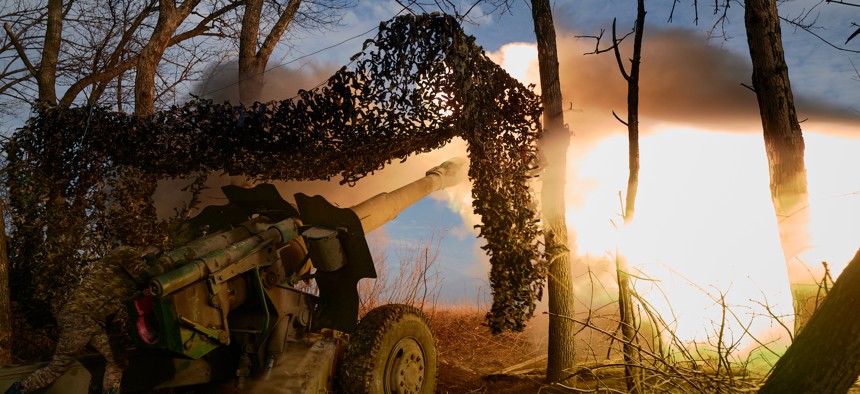
An artillery division of the 59th brigade fires on Russian forces on the frontline near Donetsk on December 23, 2022 in Donetsk, Ukraine. The division is firing 152 mm rounds with a Howitzer D20 cannon supplied by the United States. Getty Images / Pierre Crom
Army May Consider Buying Weapons Parts in Advance to Avoid Delays
The service should look at weapons buying “in a nonlinear way,” Army Chief of Staff Gen. James McConville said
The Army should consider stockpiling critical weapons parts to avoid replenishment delays in the event of a conflict, the service’s top uniformed leader said Wednesday.
Since Russia invaded Ukraine last February, the United States has pledged some $24.9 billion worth of weapons to Kyiv, from 155mm howitzer rounds to missiles, which, coupled with supply chain problems, has raised concerns about defense companies’ ability to restore stocks before the next conflict.
The Army could consider buying weapons “in a nonlinear way” from their “supply network” ahead of a potential conflict, Army Chief of Staff Gen. James McConville said during an Association of the United States Army event in Arlington, Virginia. An example would be purchasing in advance—and stockpiling—parts that take longer to get and cause delays.
“We may need to do things differently in the future. If it takes two years to build a certain missile…and we think we need a thousand of those systems, we need to take a look at how they're built,” McConville said. “So, the fact we have those long lead items, we actually reduce the resupply to three months rather than two years, you know just sitting on the shelf… So when something happens when you have the money, you can reduce the amount of time to stand up your organic industrial base or to start producing at the level you need.”
Because of the great need for artillery in the Ukraine war, the Pentagon has had to dip into its overseas stockpiles in South Korea and Israel, the New York Times reported.
Congress has been providing funding to help the Army ink contracts with defense companies to replenish their stock piles; however, that will take years. But McConville believes defense companies will respond to the increased demand.
“Industry is going to invest in areas that they think there's going to be a return on their investment. Many of these systems is going to have to be a long-range investment,” he said, adding, “My sense is if they see resources being put in, investments being made, and contracts being signed, they gotta get after that.”
Replenishing weapons and equipment is also an opportunity for the Army to buy the latest version of the system. For example, McConville said the Army would like the M113 armored personnel carriers it gave to Ukraine to be replaced with the newer armored multi-purpose vehicle, he said.
“So we're actually improving the readiness of the Army rather than buying or replenishing with old type things. So that's the philosophy… there is cost associated [with] that, but that is the intent of what we're trying to do when it comes to those systems.”



